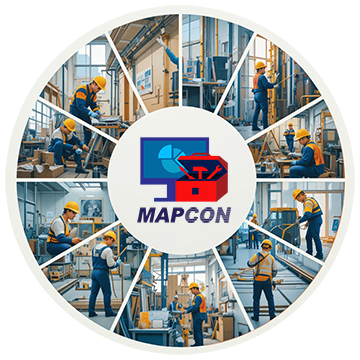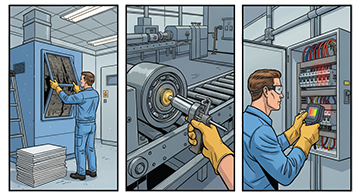Published: October 01, 2025 | Updated: October 01, 2025
Published: October 01, 2025 | Updated: October 01, 2025
Why a CMMS Gives Businesses a Competitive Edge
 Everyone searches for an advantage in today’s competitive world. Sports teams design smarter plays, businesses craft unique customer experiences, and professionals polish their resumes to stand out. For industries that rely on equipment and facilities, that edge often comes through technology. A computerized maintenance management system (CMMS) provides that edge by transforming how organizations handle maintenance, assets, and operations.
Everyone searches for an advantage in today’s competitive world. Sports teams design smarter plays, businesses craft unique customer experiences, and professionals polish their resumes to stand out. For industries that rely on equipment and facilities, that edge often comes through technology. A computerized maintenance management system (CMMS) provides that edge by transforming how organizations handle maintenance, assets, and operations.
The Pursuit of the Competitive Edge
Throughout history, innovation has consistently replaced older, less efficient methods. The printing press replaced hand-copying manuscripts. Steamships replaced sailing vessels. Automobiles overtook horse-drawn buggies. These transitions were not only about speed but also about precision, accessibility, and consistency.
Today, industries continue this pursuit by investing in digital tools. Companies in sectors such as manufacturing, healthcare, logistics, hospitality, and energy constantly seek ways to gain efficiencies while protecting their bottom line. Maintenance departments, often overlooked, play a critical role in this process. Equipment breakdowns cost money, downtime damages customer relationships, and poor inventory tracking creates waste. That is where a CMMS changes the game.
From Spreadsheets to Smart Tools: Key CMMS Advantages
Spreadsheets have long served as a basic tool for tracking equipment and inventory. They work well at a small scale but collapse under the weight of growing complexity. A CMMS provides far more than a digital grid of data. It delivers structured organization for asset records, depreciation schedules, preventive maintenance plans, inventory management, work orders, and purchasing.
In manufacturing, for instance, production lines may consist of hundreds of machines with varying lifespans. Each requires scheduled inspections, replacement parts, and specific technicians. Spreadsheets lack the ability to connect these elements dynamically. A CMMS, however, links each machine to its history, parts, and work orders, creating a living system rather than static lists.
Enhancing Maintenance Communication with CMMS Tools
Maintenance activities depend heavily on communication. A technician completing a work order benefits from detailed checklists, step-by-step job instructions, safety protocols, and visual aids. With a CMMS, these elements are embedded directly into the work order, accessible on a desktop or mobile device.
Feedback also flows upward. A technician can leave notes about unexpected conditions, attach photos of an issue, or record the time spent on each task. This bidirectional communication creates a record that not only informs management but also assists future jobs. For industries like aviation maintenance, where safety and precision are paramount, this level of communication builds accountability and confidence.
Smart Scheduling with CMMS: Less Chaos, More Control
Traditional calendar software can organize appointments, but it rarely accounts for the complexity of maintenance scheduling. A CMMS includes a dedicated calendar for preventive maintenance and work orders, assigning tasks to specific individuals, departments, or shifts.
Consider a hospital environment where life-saving equipment such as MRI machines, ventilators, or surgical tools must remain operational. A missed preventive maintenance inspection can result in equipment downtime at critical moments. A CMMS calendar avoids these risks by automatically generating recurring tasks, sending reminders, and tracking completion. The clarity of scheduling reduces chaos and safeguards essential operations.
Discover how streamlined maintenance processes can elevate production. Learn more.
CMMS Mobility: Efficiency On-the-Go
One of the most powerful advantages of a CMMS lies in mobility. Modern systems run on mobile devices, allowing technicians to scan barcodes, view asset histories, or update work orders from anywhere in the facility.
In the logistics industry, where warehouses span thousands of square feet, mobility eliminates wasted trips back to the office. A forklift in need of service can be tagged and documented in real time, ensuring immediate response. This efficiency translates into reduced downtime and lower operational costs.
Asset Management Software That Scales with Your Growth
Many software platforms require users to purchase entire packages, paying for features they will never use. CMMS solutions are often modular, meaning businesses can invest only in the features they need.
For example, a small manufacturing plant might begin with preventive maintenance scheduling and inventory management. As the company grows, it can expand into predictive maintenance, purchasing integration, or multi-site management. The scalability allows a CMMS to evolve alongside the business rather than forcing premature investment in unnecessary tools.
Better Records, Smarter Decisions: CMMS Reporting Advantages
Data drives modern decision-making, and a CMMS transforms raw inputs into actionable insights. Every entry—from labor hours to part costs—feeds into reports that help managers evaluate performance and justify budgets.
In the energy sector, for instance, compliance reporting requires meticulous documentation of inspections, safety checks, and equipment maintenance. Generating these reports manually consumes countless hours. A CMMS automates the process, ensuring accuracy while freeing employees to focus on strategic priorities. Integration with accounting or enterprise resource planning (ERP) systems further ensures that financial data aligns with operational realities.
Logical Design for Practical Use
Some business software overwhelms users with cluttered menus, endless tabs, and confusing navigation. A CMMS succeeds only when it simplifies complexity. Its design prioritizes usability, ensuring that technicians, managers, and executives can all find the information they need quickly.
For facilities management in hospitality, where staff turnover can be high, intuitive navigation reduces training time and prevents costly errors. Logical organization keeps the focus on maintenance tasks rather than navigating a maze of digital confusion.
The Value of Training in CMMS Software Implementation
Technology alone does not deliver results. People must understand how to use it effectively. CMMS vendors typically offer a range of training options, from on-site sessions to virtual modules. These sessions provide direct guidance, allowing users to ask questions and practice real-world tasks.
Industries with strict regulations, such as pharmaceuticals, depend heavily on well-trained maintenance staff. Training ensures not only operational efficiency but also compliance with industry standards. Companies that invest in proper CMMS training see faster adoption and higher returns on their investment.
Software without reliable support quickly becomes a liability. CMMS vendors that provide phone support, live chat, and even remote troubleshooting create stronger customer relationships. Maintenance issues often require immediate answers, and delays can lead to significant downtime.
In the aviation sector, where every hour of downtime can cost thousands of dollars, responsive support is critical. A strong vendor relationship means companies can resolve technical challenges quickly, minimizing disruption and protecting productivity.
Innovation That Keeps Pace
Industries evolve, and so must their tools. A strong CMMS vendor continuously releases new features that reflect changing business needs. This innovation keeps maintenance practices aligned with technological advancements such as predictive analytics, IoT sensors, or AI-driven forecasting.
In smart factories, IoT devices feed real-time data into the CMMS, predicting failures before they occur. This proactive approach reduces downtime, increases asset lifespan, and reshapes how industries view maintenance. Without ongoing innovation, companies risk falling behind their competitors.
How CMMS Advantages Play Out Across Industries

- Manufacturing: Reduces unplanned downtime and ensures production lines stay operational.
- Healthcare: Guarantees that life-saving equipment receives preventive maintenance on time.
- Hospitality: Maintains guest satisfaction by keeping facilities and equipment functional.
- Energy: Enhances compliance with safety standards while lowering equipment costs.
- Transportation and Logistics: Keeps fleets and warehouses in peak condition with mobile updates and clear scheduling.
Across each industry, the CMMS represents more than just software—it becomes a strategic advantage.
The Role of CMMS in Tomorrow’s Operations
The search for an edge never ends. New challenges arise as industries adopt advanced machinery, expand facilities, and face growing customer expectations. A computerized maintenance management system offers the foundation for meeting these demands by making maintenance more efficient, connected, and adaptive. The companies that invest in CMMS today set themselves up not just for smoother operations but for long-term competitiveness in an evolving marketplace.
FAQs
What is a CMMS and how does it benefit businesses?
A CMMS (Computerized Maintenance Management System) helps businesses manage assets, schedule preventive maintenance, and track work orders for improved efficiency and reduced downtime.
How does a CMMS improve maintenance efficiency?
By centralizing data, automating schedules, and providing mobile access, a CMMS streamlines maintenance tasks and reduces operational delays.
Why should companies consider MAPCON’s CMMS software?
MAPCON’s CMMS offers modular features, mobile accessibility, and predictive maintenance tools that adapt to growing business needs.
Can a CMMS replace spreadsheets for asset management?
Yes, a CMMS provides dynamic tracking of assets, work orders, and inventory, which is far more efficient than static spreadsheets.
How does CMMS support compliance and record-keeping?
It automatically documents inspections, maintenance activities, and part usage, ensuring accurate reporting and regulatory compliance.
What industries gain the most from using a CMMS?
Manufacturing, healthcare, hospitality, energy, and transportation industries benefit from reduced downtime, preventive maintenance, and improved operational efficiency.
MAPCON | 800-922-4336
MAPCON CMMS software empowers you to plan and execute PM tasks flawlessly, thanks to its wealth of features and customizable options. Want to see it for yourself? Click the button below to get your FREE 30-day trial of MAPCON!
Try It FREE!